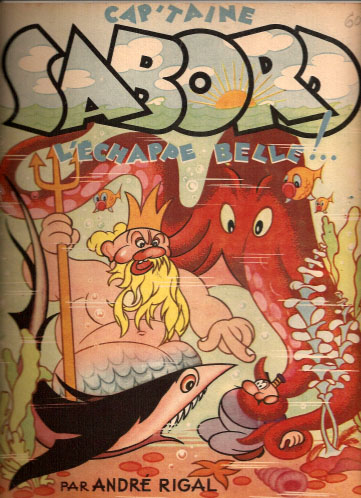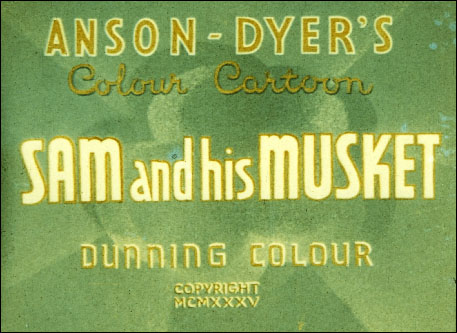This week from Mark Kausler’s Film Vault – two films from England and one from France. First up:

The Mysterious Island (André Rigal, 1943) Animator and print comics cartoonist André Rigal made several animated films using his Cap’taine Sabord character in the early 1940s, during the Nazi Occupation Of Fance. This particular one has US home movie titles. “I have another Captain Sabord, too. In French,” Kausler told me. If its as much fun as this one, I want to see it!

Sam’s Musket (1935) Mark has a black & white print (missing the title card above) of this rare film originally produced in Dunning Color. “British cartoonist Anson Dyer’s biggest hit. It features Stanley Holloway narrating the story, based on his famous monologues about soldier Sam Small”. Astor Pictures released the series of these films (I believe their were five) in the US in 1936.
Widdicombe Faire (1947) by the Larkins Studio of England, is a rendition of the traditional English folksong ‘Widdicombe Fair’, accompanied by drawings. “I like how quietly this cartoon starts out, with a little song about the Faire, then toward the end, the visuals take on a mysterious and witchcraft tinge,” says Kausler. “One of my favorite British cartoons.”
As always, reader’s contributions to our collective knowledge is always welcome (in the comments below).
Next Week: Films from the Carpenter-Goldman Studio.


 Jerry Beck is a writer, animation producer, college professor and author of more than 15 books on animation history. He is a former studio exec with Nickelodeon Movies and Disney, and has written for The Hollywood Reporter and Variety. He has curated cartoons for DVD and Blu-ray compilations and has lent his expertise to dozens of bonus documentaries and audio commentaries on such. Beck is currently on the faculty of CalArts in Valencia, UCLA in Westwood and Woodbury University in Burbank – teaching animation history. More about Jerry Beck [
Jerry Beck is a writer, animation producer, college professor and author of more than 15 books on animation history. He is a former studio exec with Nickelodeon Movies and Disney, and has written for The Hollywood Reporter and Variety. He has curated cartoons for DVD and Blu-ray compilations and has lent his expertise to dozens of bonus documentaries and audio commentaries on such. Beck is currently on the faculty of CalArts in Valencia, UCLA in Westwood and Woodbury University in Burbank – teaching animation history. More about Jerry Beck [



































Disney was looking at switching to Dunning Colour, according to a Variety story of Jan. 7, 1937, at least when it was able to perfect a three-colour process. The end of the story states: “English film cartoon, ‘Sam and His Musket,’ is said to be preparing to expand from two color to three shortly.” I gather from the trades that Carroll Dunning wasn’t satisfied with the three-colour version until 1941.
I seen another Sam Small cartoon entitled “Sam’s Medal” which was shown on the UK TV channel Talking Pictures TV last year. Again, it was a B&W print.
I can’t add to the collective knowledge, alas. All I can do is express my appreciation for these offerings from artists and even studios I never heard of before Mr. Kausler so generously shared them with us. Thanks!
I was very, very lucky to get a cheap copy (roughly $25) of Dennis Gifford’s “British Animated Films, 1895-1985”. I only wish I was as equally lucky to get cheap copies of his other masterworks covering British narrative (live-action) and documentary films, which are rare gems that predictably carry huge price tags these days… if you can find them. Only small portions of all of his valuable research information is scanned online. Given the time period when Gifford did his research, long before the internet when he only had vintage paper printed periodicals to reference, it is inevitable that a few titles get missed. Plus the animation book only covers the theatricals; not anything done for TV. Now that we have the internet… we are blessed with the Internet Archive scans of a couple (sadly, not all) Kinematograph Year Books, which include trade show dates for many features and shorts that are… fairly close… to the wider theatrical release dates.
I know this is pointless information, but in case it is needed… here is the original UK series released by Anglia Films in glorious Dunningcolor:
Sam And His Musket / October 24, 1935 (Kinematograph Weekly review)
Alt! Oo Goes There? / April 22, 1936 (Kinematograph Weekly review)
Beat The Retreat / November 7, 1936 (Today’s Cinema 7 review)
Sam’s Metal / November 7, 1936 (Today’s Cinema 7 review)
Drummed Out / February 19, 1937
Gunner Sam / May 4, 1937 (Today’s Cinema 7 review)
… or, rather, Dunning Colour. I am hardly great at catching my own spelling errors.
Funny you mentioned Dennis Gifford, I have a hardbound copy of his “The International Book of Comics” my mom had found used somewhere in the 80’s! I blame that for getting me into comics at an early age!
https://www.amazon.com/International-Book-Comics-Denis-Gifford/dp/B004WI3MOM/ref=tmm_hrd_swatch_0?_encoding=UTF8&qid=&sr=
I may be mis-remembering, but I saw Sam’s Musket at The National Film Theatre (part of the British Film Institute) – and I’m pretty sure that was a colour print – though this would have been 20 or 30 years ago so perhaps I am mistaken on that part. Was great to see it again.
Ha! I too have one of those old USA Home Market 16mm prints of the ‘Little Skipper” in THE MYSTERIOUS ISLAND. Always love the weird ones!
I wonder if Captain Sabord has a German cousin who hangs around with a couple of hellions named Hans and Fritz? The music in Mysterious Island is also interesting in how often a familiar-sounding tune morphs into an alternate-world variation, like when the intro to “The Peanut Vendor” (at 5:25) becomes something else. And at 6:20, we get what sounds like the start of something by Raymond Scott, but isn’t.
That’s awesome! Thanks for posting. I didn’t even realize England and France made cartoons back then.
Most countries started experimenting with animation several decades before the 1940s. Even in Scandinavia (my home region), the early animation pioneers had gotten started by the 1910s.
Thanks, Mark & Jerry! Here’s another Captain Sabord. https://youtu.be/JFXhQj0u_vc
In SAM’S MUSKET, there are some bits of action that look (to me) as if they could have come out of an Iwerks Comicolor (Sam angrily approaching the sergeant at 2:15; the sergeant’s shrug at 4:55 are almost Irv Spence-ian). As Iwerks was doing some animation for the British market close to the time (the Boots Chemists cartoon, the GRAN’POP cartoons), could there have been some cross-pollination?
Thanks Milton, that was the other Captain Sabord I had on 16mm. The one you posted has different main and end titles than mine, but all the rest, including the song, is the same. Thanks again, Mark
The British Film Institute possess nitrate negs and colour prints for all the Sam Small cartoons except Beat The Retreat. There is a touring DCP package of British animation recently restored by the BFI containing a one-shot Dunning Colour cartoon adaptation of Carmen from the same period sporting fairly similar Iwerks-esque character designs:
https://mobile.twitter.com/stewjeez/status/943125477522370560
Most of the Larkin’s Studios works are also preserved at the BFI. In fact they have uploaded their own transfer of Widdicombe Fair online for free (albiet geo-locked only if you reside in the UK):
https://player.bfi.org.uk/free/film/watch-widdicombe-fair-1947-online
The sound on their print certainly is much louder than presented here for Widdicombe Fair. Also interesting it lacks subtitles for the tune.
I find it interesting how Cap’taine Sabord’s “first mate” bears a striking resemblance to Popeye, sans the distinct cleft chin. I got the impression that Rigal took inspiration from the Fleischer Popeye cartoons of the 30’s.
I’m looking for the cartoon series that had a character. Oh I know it was called Tooner ville Trolley the two characters were the driver of the Trolley and his daughter Katrinka. Does anyone know where I might watch it?
Check this post: https://cartoonresearch.com/index.php/technicolor-rainbow-parade-model-sheets/